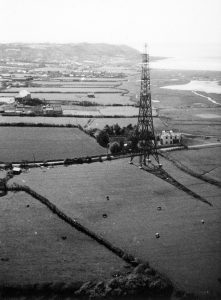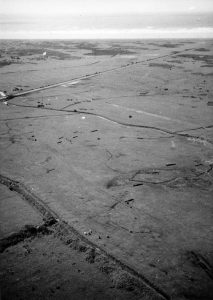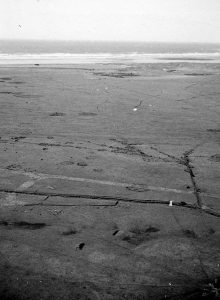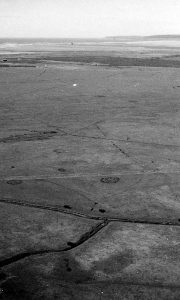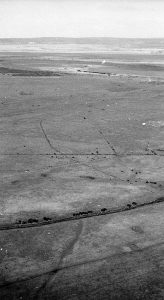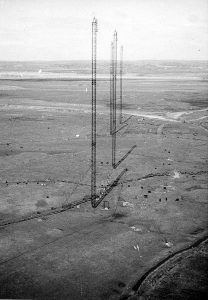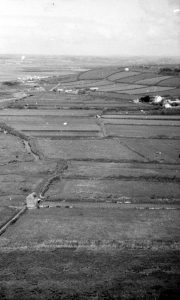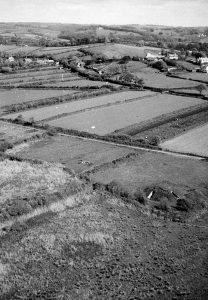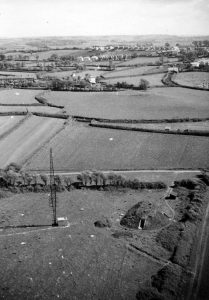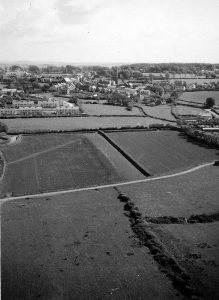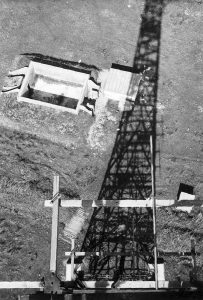Memories of the War Years, by Richard Sumner
I lived between Northam and Diddywell from 1929 and 1958 (I was born in 1929). In 1947 I climbed one of the wooden radar masts and from the top I photographed a panorama of about 360 degrees. My camera was basic and I developed and printed the film myself so the quality of the prints is not brilliant.
Bideford, Northam, Appledore, Westward Ho.
This triangle of North Devon formed my youthful world. Whether in a pushchair, walking or on a bicycle I got to know it very well, all the little nooks and crannies. Bideford was the Town; Northam, the Village; Appledore, an interesting and slightly exciting fishing and boatbuilding town; Westward Ho, a popular seaside resort. Between Westward Ho and Appledore were The Burrows on which was the Royal North Devon Golf Course – at that time a championship course. ‘Over the Burrows’ was where we went to bathe, in Bideford Bay (NOT Barnstaple Bay we insisted). Our house was on the lower Appledore road half a mile from Northam. The house was demolished in the 1980s after its land had been developed into a housing estate, but between 1929 and 1958 it was my home.
Northam was half a mile from the house and was visited daily. All the necessary shops were there and most of them delivered their goods. The two misses Burch owned the bakery in the Square; a butcher was nearby, a garage and Glovers the hardware shop. Opposite was a sweet shop. Bishop’s the grocer, the bank, the Post Office, the chemist. Also a carpentry, a slaughterhouse (on Tuesdays one heard the squeals of the pigs being killed), the coal merchant, and a blacksmith where I used to watch the horses being shod. A quiet, gentle community where everyone was known and very little disturbed the daily routine. Mr Pinney, the vicar, was active around the village, we went to church every Sunday and father sang in the choir. From the village you could see out over the Burrows to the sea and Lundy Island in the distance.
The road to our house left the square down a short, steep hill and the horse-drawn wagons going down it had to have cast iron skids under their wheels to brake the descent. The roads in the area had only recently been covered with tarmac after they had been dug up to lay main drainage; many others were still only dirt, dusty in summer and muddy in winter. We had a car, an open Fiat with a canvas roof; when this was down our dog used to be placed in a fold, until one day the bumpy road threw him out.
Westward Ho had developed as a popular seaside resort in Victorian times probably as a result of Charles Kingsley’s and Rudyard Kipling’s stories. Kipling had been at the United Service College in the 1870s and wrote about it in “Stalky & Co”, but after it left in 1904 the area declined somewhat. The long, flat stretch of sand facing the Atlantic gave good, safe bathing, and I remember Sir Alan Cobham’s flying circus using it for their five shilling (25p) flights for the public – my sister went on one. Nearby was a sheltered, salt-water, swimming pool where I learned to swim. It had been opened in July 1875 as The Nassau Baths but in 1930 it was called The Patio and was owned and run by Major Pleydell-Bouverie, a retired army officer, and I was always fascinated by his pumping engine and cleaning operations. It was a favourite summer place for the family and was very pleasant with its sheltered walls, ice creams, and music – ‘Sleepy Lagoon’ was always playing. Now (2007) it has been developed into 26 luxury appartments. Some houses, a few shops, a putting green, a row of huts, and a holiday camp was about all there was to Westward Ho, however it was fun to visit when there was rough weather as the surf was big along the sands and waves would break over the sea wall and pebble ridge. We mostly bathed further along the Pebble Ridge, over the Burrows.
Appledore was more interesting as it was a working community with fishing boats and shipbuilding yards. It had a lifeboat station. The narrow streets and tiny houses were always a fascination but they have now been gentrified as desirable second homes. Near to the village was a sandy bay at which old wooden coastal trading boats were beached and dismantled; they were exciting for us to explore. We used to go into the old cabins and holds and imagine ourselves at sea. The smell of bilge water, oil, and tarred wood is a very strong reminder of those days.
Bideford was two miles away and something of an excursion to visit. We usually went on the bus from Northam, and sometimes in Sammy Guard’s bus which went past our front gate. This was a large, open, old fashioned charabanc; the canvas hood only being used if it rained. Sammy was a large, colourful character and on market days, when it would be full of Appledore folk, the journey was usually a riot of screams of laughter as he made remarks about his passengers – one had to expect to be singled out for attention. The town was a very pleasant one built alongside the river Torridge.
The Quay was the centre of activity, always busy with small coastal shipping unloading and loading and the few cars parking there, the shopping streets running uphill from it. It was a happy mix of commerce and community enhanced by the attractive river and the old many-arched bridge. The summer regatta held at high tide was right in the middle of the town and was a great occasion. My sister had had a canvas canoe and in it she won the race for girls. The town had all the essential shops but I had my favourites: Gales the sports and gun shop, Puddicombes the toy shop where there was a drawer of toys which cost only one penny, Chopes the drapers, The Old Bank Café where there were back copies of ‘Punch’ magazine which I liked – aged four I startled a man sitting next to them by asking him to “give me a Punch”. The pannier market at the top of town was always attractive. The cool, vaulted building filled by the local farmer’s wives with their produce was really ‘direct to the consumer’: cream, butter, eggs, junket, all manner of meat, and vegetables, and, of course, fish straight from the quayside. It was always thronged with customers. There were also two cinemas – The Strand and The Palace; they showed the early films like Gone with the Wind, and Roy Rogers cowboy films, even some silent ones. Somehow the town gave the feeling of pride in its ancient sea-faring history with the names of Sir Walter Raleigh, Sir Francis Drake still resonant. I liked it and am saddened by the changes of the last fifty years – the modern road bridge over the river has spoiled it for me.
Gallery of photo’s by Richard
(click images to enlarge)
